We are pleased to publish this important article by Associate Professor Efe Can Gürcan, which sets out what he describes as the ‘Chinese miracle’, “that China has enjoyed unprecedented economic success in world history despite enormous historical, demographic, geographical and geopolitical adversities.” Despite this, he notes, “China has developed an exemplary model of economic development that inspires much of the developing world.” Therefore, “to decipher the formula behind China’s historic economic success” is to “offer fundamental hints to guide developing countries in their endeavours to reach an advanced stage of economic development.”
Professor Gürcan surveys the various stages of China’s socialist development under Mao Zedong, Deng Xiaoping, Jiang Zemin, Hu Jintao and Xi Jinping, noting that “the roots of the Chinese economic miracle can be traced back to the early phase of the Chinese revolution under the leadership of Mao,” who he sees as the real originator of the concept of socialism with Chinese characteristics. Deng Xiaoping developed this, including by digging deeper into Mao’s work, for example his, ‘A Critique of Soviet Economics’, and he highlights Deng’s view of the essence of socialism lying in the “liberation and development of the productive forces, elimination of exploitation and polarisation, and the ultimate achievement of prosperity for all.”
Professor Gürcan concludes by stating that: “In contrast to Western capitalism, the Chinese economic miracle does not originate from forced accumulation, wars, and colonialism. On the contrary, it springs from peaceful development and international cooperation. Understood as such, China’s model also constitutes the living example of the rising relevance and superiority of socialism over the capitalist system.”
This is an extremely important article that is worthy of careful study. It was originally published in Volume 3 Issue 2 of the Turkish journal Belt and Road Initiative Quarterly (BRIQ) and is reproduced with thanks. The article can be also be read/downloaded in PDF form.
Abstract
Despite enormous historical, demographic, geographical, and geopolitical adversities, China has enjoyed unprecedented economic success in world history. This article aims to decipher the formula behind China’s historic economic success and distill policy lessons for developing countries in their endeavors to reach an advanced stage of economic development. Based on descriptive case study and statistics, the article suggests that the Chinese economic miracle can be explained by a four-fold formula: a) devising an autocentric economic model aspiring to improve national autonomy and cushion the impact of foreign interference, b) insisting on socialism and the leadership of the Communist Party of China (CPC), which allows for strategic coherence and long-term planning to overcome free-market anarchy, c) creating a state-driven industrial base fueled by national science and technology policies, and d) adopting a balanced approach to development centered on attaining a higher sociocultural and ecological quality of life. The findings also help to debunk the myths surrounding the Chinese miracle, particularly the “cheap labor thesis”, the “technology theft thesis”, the “foreign investment and capitalist integration theses”, the “imperialism thesis”, and the “Mao-the-monster thesis”.
Keywords: Chinese miracle,economic development, Mao Zedong Thought, socialism with Chinese characteristics, Xi Jinping Thought
Deciphering the Chinese Economic Miracle: Lessons for the Developing World
The “Chinese miracle” has become a widely used term in development studies, inspiring developing countries to achieve high levels of prosperity, living standards, and stability over the last decade. The popularity of this term can be explained in large part by the fact that China has enjoyed unprecedented economic success in world history (Zakaria, 2011; Gürcan 2021a), despite enormous historical, demographic, geographical, and geopolitical adversities. China was one of the world’s poorest countries before the socialist revolution in 1949. In the early revolutionary era, China struggled much to overcome its crippling semi-colonial legacy characterized by the medieval conditions of an agricultural economy and the weakness of its industrial base. History aside, China is the largest country by population size, which currently accounts for 22% of the world’s population. This goes hand in hand with China’s resource scarcity problem as a structural adversity constraining its development potential. China possesses only 7% of the world’s arable land and freshwater resources and 8% of the world’s natural resources. Furthermore, only 19% of its surface area is suitable for human habitation, and 65% of its surface area is rugged. This severely cripples China’s farming capabilities and facilitates ethnic heterogeneity as a potential impediment to political cohesion (Morton, 2006; Naughton, 2018). Another adversity threatening China’s economic development concerns geopolitical circumstances. Cases in point are how China’s membership in the United Nations was stalled until 1971, and the US resorted to military interventions in China’s neighboring regions to suffocate the revolution. The current geopolitical circumstances find their sharpest expression in the current US containment strategy and the US-led trade and technology war against China (Gürcan, 2019; Gürcan, Kahraman & Yanmaz, 2021).
Despite such adversities, China has developed an exemplary model of economic development that inspires much of the developing world. Since 1979, China is the only country that has remained untouched by any economic crisis. The 1979-2018 period testified to an average economic growth rate of 9.4% in the lead of the CPC, making China the world’s second-largest economy, top producer, and the leading exporter of technological goods (Hu, 2020). By 2015, China came to assume the global production of 40% of washing machines, 50% of textiles, 60% of buttons, 70% of shoes, 80% of televisions, and 90% of toys. Recently, China has made significant progress in producing higher-value added products in the computer, aviation, and medical technology sectors, among others. One should also note that China has risen to the world’s largest lender to the developing world, second-largest investor in foreign direct investment (FDI), and top leader in green bonds and credits. China’s contributions to green finance also bring to mind China’s global leadership in sustainable development. China has recently emerged as the world’s top leader in green transportation as the largest producer of electric buses and the largest market for electric vehicles and bikes. Similarly, China’s status as the world’s top producer of solar, wind, and hydroelectric power is closely related to its reputation as the world’s top investor in sustainable energy technology (Gürcan, 2021a). Besides China’s historic success in economic and environmental development, one should also note that the Chinese economic miracle is credited for 70% of global poverty eradication between 1990 and 2015 (Gardner, 2018).
This article aims to decipher the formula behind China’s historic economic success and offer fundamental hints to guide developing countries in their endeavors to reach an advanced stage of economic development. This article suggests that the Chinese economic miracle can be explained by a four-fold formula: a) devising an autocentric economic model aspiring to improve national autonomy and cushion the impact of foreign interference, b) insisting on socialism and the leadership of the CPC, which allows for strategic coherence and long-term planning to overcome free-market anarchy, c) creating a state-driven industrial base fueled by national science and technology policies, and d) adopting a balanced approach to development centered on attaining a higher sociocultural and ecological quality of life. This formula is derived using the method of descriptive case study, which is a research method that consists of an intense historical study of “a single instance of an event or phenomenon” by “get[ing] the history down for the possible benefit of later policymakers” and drawing “memorable analogies that later practitioners use to identify… strategies that work” (Odell, 2001: 162). The present article provides an intense study of the phenomenon called the “Chinese economic miracle” by distilling policy lessons for developing countries. It is structured in three sections. The first sheds light on the Mao Zedong era, which was characterized by a centrally planned economy and a big push strategy, whereas the second addresses the Deng Xiaoping and Jiang Zemin eras with a special focus on reform and opening-up. The subsequent section shifts the focus to the Hu Jintao and Xi Jinping eras by revisiting the success of China’s social development strategies. It also points to the leading role of the state in China’s economic development and its contribution to innovation and technology.
The Legacy of Mao Zedong’s “Big Push” Strategy
The roots of the Chinese economic miracle can be traced back to the early phase of the Chinese revolution under the leadership of Mao (1949-1976). Mao’s leadership adopted what might be called a “big push strategy” for rapid industrialization to rapidly catch up with Western powers that once succeeded in turning China into a semi-colony. This strategy relies on central planning, by which the state “channel[s] the maximum feasible investment into heavy industry” and “mobilize[s] saving and investment, sacrificing consumption today in order to benefit future generations” (Naughton, 2018: 65). Indeed, the big push model as an economic term that can be generalized to other countries found its sharpest expression in the Chinese context under the name “Great Leap Forward”, which was part of China’s Second Five Year Plan (1958-1962). This being said, the general trend that characterized the period between the First Five Year Plan and the Fifth Five Year Plan (1953-1980) complied with the Big Push Model for the most part:
In 1953, the central government launched its first FYP (1953-1957), which aimed at turning China from a agricultural country into an advanced industrial country with a focus on the development of the heavy industry. The next five FYPs put emphasis on agricultural and industrial development. The second FYP (1958-1963) carried on the industrial development centered on heavy industry. The major tasks of the third one (1966-1970) were to develop agriculture and strengthen basic industries. The fourth (1971-1975) set goals for output of agriculture and industry and investment in infrastructure. The fifth FYP (1976-1980) set up a goal of building up an independent and relatively complete industrial system (CGTN, 2020).
A word of caution is warranted at this point before proceeding further. History as an academic discipline provides us with a powerful tool to learn from humanity’s past struggles and successes (Gürcan, 2008). However, judging past actions by today’s moral standards would nullify the scientific value of history, setting the ground for misleading analogies. The case of China under Mao’s leadership is not immune to this principle. As Barry J. Naughton argues, therefore, “at the time of the birth of the PRC, many people believed that this [big push strategy] was the best approach to development”, despite human costs (Naughton, 2018: 65). Nevertheless, the ultimate result of this strategy was a historic economic success, which can inform today’s policymakers about the use of public-driven or state-guided economic development models to be redesigned in conformity with today’s moral standards. One should also note that China’s current economic policies are still grounded on Mao’s legacy of big-push industrialization.
Mao’s strategy of economic development draws its strength from the principles of “socialism with Chinese characteristics” (有中国特色的社会主义). These principles proceed from the assumption that universal models or widely accepted standards “must be combined with specific national characteristics and acquire a definite national form if it is to be useful” (Mao, 1967: 61), which also applies to the usefulness of economic development strategies. With these principles in mind, Mao calls for abandoning dogmatic and bookish interpretations by “seeking truth from facts” while learning from past mistakes and successes. Mao’s “socialism with Chinese characteristics” is thus a call for integrating socialist principles with China’s historical peculiarities and changing realities (Mao, 1971; Gürcan, 2008). This framework later encouraged Chinese policymakers to create an endogenous economic model based on socialism (Naughton, 2018; Currie-Alder, 2014; Harrison, 2020).
Mao’s big push strategy encouraged heavy investments in both physical and human capital, which led not only to significant scientific, technological, and industrial advances but also to the inclusion of a majority of the Chinese population in the public health and education systems for the very first time in China’s history. Scientists and engineers were mobilized under a centralized science and technology system, providing the human capital necessary for big push industrialization (Naughton, 2018; Currie-Alder, 2014; Harrison, 2020). China’s First Five-Year Plan was launched in 1953. Before implementing this plan in 1952, China was predominantly an agricultural country, and the contribution of industry to Gross Domestic Product (GDP) was only 20%, which used to take the smallest share of the economy. In the 1952-1978 period, the Chinese economy grew by 6% on average, whilst the average growth rate of industrial output was 11.5% (Naughton, 2018; Chan, 2018; Dollar, Huang & Yao, 2020). By the second half of the 1970s, the big push strategy and its policy of high savings and limited individual consumption resulted in industry overtaking agriculture and the service sector becoming the largest sector with a share of 46% in the economy (Dollar, Huang & Yao, 2020). As a result of social advances in public health and education, China’s average life expectancy rose from 25 in 1931 to 63-66 by 1956 (Kiely, 2015).
The Reform and Opening-Up Strategy in the Post-Mao Era
The policymakers of the early phase of the Chinese Revolution were experienced revolutionaries who had successfully carried out a protracted revolutionary struggle, but they lacked experience and knowledge in political and economic statecraft. Mistakes were thus unavoidable in the process of exploration through trial and error. Indeed, it is difficult to over-emphasize the substantial gains from the big push strategy, which served as a springboard for the Chinese economic miracle to build a strong physical and human infrastructure for socialist construction. In the late 1970s, however, it became apparent that policymakers’ tendency towards impetuosity and rash advances for rapid industrialization was not sustainable in the longer term. Moreover, the late 1970s and early 1980s testified to the exhaustion of the Soviet model of development due to a stagnating Soviet economy coupled with the alienating effects of the Sino-Soviet split, which made the Chinese question the feasibility of continuing a Soviet-modeled system. In this context, Chinese policymakers grew a stronger awareness that China is still in the early phases of socialist construction and that this situation will last longer than expected due to several constraints, including the long-term retreat of the international communist movement and the advent of capitalist globalization under the Third Industrial Revolution. Relatedly, China’s new leadership forged around Deng required an entirely novel framework to mobilize the economy by taking advantage of globalization and ensuring the legitimacy of the economic model after the power vacuum created by Mao’s death. According to Chinese policymakers, this was a viable alternative to rapidly surpass the Soviet Union and catch up with the West without sacrificing domestic stability.
In the late 1970s, Deng proposed digging deeper into Mao’s theoretical contributions to “socialism with Chinese characteristics” and preparing a blueprint for China’s modernization by shifting the focus from class struggle to the fundamental task of expanding the country’s productive forces, which are viewed as the “foundation” of Chinese socialism (Deng, 1987: 17; Gürcan, 2021b). As originally conceived, this blueprint proceeds from the argument that “economic development is our primary objective, and everything else must be subordinated to it,” drawing on Mao’s subsequent formula offered in A Critique of Soviet Economics (Deng, 1987:116; Mao, 1977). Worthy of note here is that this formula provides an earlier framework for state capitalism and modernization: “In addition to modernizing industry and agriculture, science and culture, we have to modernize national defense” (Mao, 1977: 65). Following Mao’s teachings on the Four Modernizations, Deng’s blueprint consists of “one focus” (economic construction centred on the development of agriculture, industry, defence, and science and technology, otherwise known as the “Four Modernizations”) and “two basic points”, i.e. (a) upholding the “four cardinal principles” (upholding socialism, the people’s democratic dictatorship, the CPC leadership and Mao Zedong Thought) and (b) the policy of reform and opening towards a system of market socialism integrated with the world economy (Deng, 1984: 187-188; Wu, 1996; CPC, 1991; Gürcan, 2021b).
It is important to emphasize that Deng’s reform strategy does not stem from a neoliberal perspective of market fundamentalism. With common prosperity and the state’s guidance of the economy in mind, Deng rather advocated for the acceleration of “foreign investment capital in a planned way… [by] serving the development of the socialist economy as a whole” (Deng, 1984: 96). He thus followed Mao’s (1961: 413) motto “only modernization could save China, only learning from foreign countries could modernize China.” Similarly, he refuted the idea “that the market is capitalist and only planning is socialist” (Deng, 1984: 136). Instead, he believed that both planning and markets could be used to serve the socialist system, whose essence lies in the “liberation and development of the productive forces, elimination of exploitation and polarization, and the ultimate achievement of prosperity for all” (Deng, 1984: 243). However, these objectives can only be realized “step by step” despite complexities and contradictions along the way: “Where conditions permit, some areas may develop faster than others; those that develop faster can help promote the progress of those that lag behind, until all become prosperous” (Deng, 1984: 244).
Deng realized that China’s size was too large for central planning to be effectively implemented in every area of the economy, which called for a less centralized system of planning (Naughton, 2018). Within this framework, China initiated the era of reform and opening up by decentralizing agriculture and gradually allowing for the privatization of the industry while “open[ing] up [China’s] industrial base to foreign contractors… [based on] very stringent guidelines that foreign contractors had to follow” (Marino, 2018:42). The idea was to benefit from foreign direct investments to transfer capital and technological knowledge in the longer term by pursuing export-driven strategies (Marino, 2018). As such, reform and opening up were used as vehicles for implementing an autocentric model of state-guided development without giving up to market fundamentalism and economic dependency on the West.
The Jiang era (1993–2002) coincided with a period in which globalization was in full swing and faced with the unipolarization of world politics under the US initiative (Gürcan, 2019; Gürcan, 2021b). According to the KOF Index of Globalisation—which takes into account the economic, social and political aspects of globalization—the world’s globalization scores underwent an almost steady increase from 38.43 in 1970 to 53.37 in 2002 (KOF Globalisation, 2020). In this era, China’s political and economic framework was shaped by Jiang’s “Three Represents” theory, which professes to represent “the requirements of the development of China’s advanced productive forces, the orientation of the development of China’s advanced culture, and the fundamental interests of the broadest masses of the Chinese people” (Jiang, 2002: 8). The “advanced productive forces” component of the “Three Represents Theory” takes off from Deng’s vision of modernization (Jiang, 2002: 183). In line with Jiang’s theory, the Chinese economy moved towards a socialist market economy with public ownership as the main form. Here, public ownership encompasses a broader scope than mere state ownership, including not only state-owned enterprises (SOEs) but also collectively-owned enterprises (COEs) and various forms of mixed ownership, such as cooperative enterprises and “equity shares in private and foreign firms that are held by SOEs and (COEs)” (Wang, 2011: 459). In 2000, therefore, China launched a going-out strategy “with the aim of establishing Chinese firms as global players, including SOEs and the state-owned commercial banks” (Yueh, 2018: 114).
Regarding the “advanced culture” component, Jiang envisioned the development of a national culture that “provide[s] spiritual and intellectual support for economic development” in line with such values as self-reliance, competition, efficiency, democracy and innovation (Jiang, 2002:188-189). Finally, when it comes to the “broadest masses” component of the “Three Represents Theory”, Jiang’s vision aimed to “bring the vast fields of society and a growing market under solid and effective Party leadership” (Jiang, 2002: 16). According to Jiang, this vision was to be realized by encouraging “party building in non-state enterprises” and extending these efforts towards “private business owners” (Jiang, 2002: 21-23).
In this period, China witnessed rapid economic growth and industrialization, which allowed for reversing income inequality, remedying environmental damage, and improving social welfare by the end of the 1990s. For one thing, China’s estimated GINI scores had changed from 0.33 in 1980 to 0.35 in 1990 and 0.4 in 2000 (Chen et al., 2010: 20; Gürcan, 2021b). To face such challenges, the Tenth Five Year Plan (2001–2005) targeted regional disparities, improving the quality of education, expanding forest coverage, increasing disposable income, accelerating infrastructure development, and bettering medical services (China Daily, 2011). One should also emphasize that the Tenth Five Year Plan imposed a stronger emphasis on the public sector: “The ownership system needs to be further improved. We need to uphold the dominance of the public sector of the economy, let the state-owned sector play the leading role, develop various forms of collective undertakings, and support, encourage and guide the healthy development of private and individual sectors of the economy (Zhu, 2001).” In the meantime, China targeted a total of 120 strategic corporations for state support. These corporations were conceived of as “national champions” who would soon become “global players”, mostly operating in strategic areas such as electricity, coal, automobiles, electronic appliances, pharmaceuticals, transportation, aviation, and information technology (Kiely, 2015).
From Balanced and All-Round Development to the Chinese Dream of National Rejuvenation: Towards a Higher Phase of Socialism in the Hu Jintao and Xi Jinping Eras
When the Hu administration (2002-2012) came into office, China’s productive forces had already attained a degree of maturity that made it possible to focus on the fight against exploitation and polarization. GDP can be used as a basic indicator of the level of development of productive forces, and the data on China’s GDP point to significant achievements in the 2000s (See Figure 1). Formulated in response to the rising tide of social unrest and taking advantage of China’s increased level of economic maturity, Hu’s theory of “harmonious society” provided a policy framework that targets the smoothing of popular unrest. In this context, the 10th Five Year Plan prioritized improving China’s social security system and state-owned enterprises, whilst the 12th Five Year Plan focused on environmental protection as part of Hu’s harmonious development blueprint while also developing education, science, and technology (CGTN, 2020). Hu’s new policy framework had a strong effect on the inauguration of Labour Contract Law (LCL) in 2008 and noticeable increases in the minimum wage by local governments. The LCL ensures registered employment along with contract renewal guarantees, social security funds, and wage standards (Gürcan & Mete, 2017: 12-13).

According to Hu, “social harmony is an essential attribute of socialism with Chinese characteristics” (Hu, 2007). His vision of social harmony was not limited to promoting “social equity and justice”. It finds its fullest expression in “balance[ing] urban and rural development, development among regions, economic and social development, relations between man and nature, and domestic development and opening to the outside world” (Hu, 2007). One cannot help but notice that Hu’s vision strongly echoes Mao’s speech entitled On the Ten Relationships, where he makes a case for balanced development in conformity with the concrete reality of China (Mao, 1974). In achieving social harmony, moreover, Hu brings the “Scientific Outlook on Development” to the centre of his policy framework, which consists of making full use of the guidance of science and education to promote a balanced, all-round, and sustainable model of development that puts people first (Hu, 2007; Gürcan, 2021b). Therefore, Hu’s vision of building a “moderately prosperous society in all respects” led him to emphasize “running the administration for the sake of the people” and “seeking harmony in the midst of differences” (Hu, 2007).
In this context, the Hu administration accelerated social policies, state-guided policies, and large-scale infrastructure investments, which the Xi administration later deepened. The Eleventh Five Year Plan (2006-2010) laid an even stronger emphasis on the public sector. It thus sought to “push the government capital to concentrate in the important industries and key fields critical to the national safety and national economic arteries, optimize state-owned economic distribution, reinforce the controlling force, influence and driving force of the state-owned economy and exert its leading function… develop big company and big enterprise groups with relatively strong competitive power… continue to deepen collective enterprise reform and develop multi-form collective economy (PRC, 2006).” This plan also accentuated building an independent base of manufacturing and innovation abilities (PRC, 2006).
Based on the context depicted above, gross fixed capital formation may be considered a basic indicator for infrastructure development. It includes not only land improvements, plant, machinery, and equipment purchase but also the construction of roads, railways, schools, offices, hospitals, private residential dwellings, and commercial and industrial buildings. Available data indicate that China’s gross fixed capital formation grew by around 7.85 percentage points in 1989-2001. Between 2002 and 2012, this growth was recorded at 9.19 percentage points under the Hu administration. Worthy of note here is that China’s state-guided economic development model allowed the Chinese gross fixed capital formation to outscore imperialist countries such as the US, the United Kingdom, Germany, and France (See Figure 2).
The expansion of China’s social policies can be assessed by reference to data on “public expenditure on social security and employment”, “government expenditure pension and social welfare”, and “domestic general government health expenditure as a percentage of current health expenditure”. Regarding social security and employment, China’s public expenditure witnessed a significant increase, which amounts to a rate of over 328% (see Figure 3). This situation is no different from China’s expenditure on pension and social welfare, having soared by more than 686% in the period 1995-2006 alone (see Figure 4). Not surprisingly, this is reflected in the increasing labor share of GDP in China, which accelerated in 2010 and reached 51.3% by 2017 (see Figure 5). In 2000, moreover, China was the second-worst performer in our sample of imperialist and developing countries in the area of general government health expenditure. However, the 2000s testified to a spectacular increase in the ratio of China’s general government health expenditure to total health expenditure, which rose by nearly 34.5 percentage points.
It thus seems that China exhibited the highest rate of increase in our sample, only to accelerate under the Hu and Xi administrations. Available data indicate that public health expenditure reached a level above 50% of total health expenditure, starting with the year 2010 (see Figure 6). A similar situation goes for China’s government expenditure on education (as a % of GDP), which rose from 1.88% in 1999 to over 3.75% in 2010 (see Figure 7). An upward trend is also observable in China’s average wages. They rose by almost 237% under low inflation conditions (see Figure 8). All of these developments were reflected in the reduction of the GINI index, or income inequality since 2010, mainly thanks to Hu’s all-round development strategy, as well as Xi’s diligent efforts later. At this point, it bears underscoring that China’s GINI index reveals China’s social advances in the 2000s (see Figure 9). China exhibited similar performance in its Human Development Index (HDI). HDI is a tool that measures human development in health, education, and the standard of living. Overall, there has been a constant increase in China’s HDI in the period 1990-2019, which amounts to an increase of 0.262 points in total (see Figure 10). In the final analysis, one could argue that these socioeconomic achievements clearly demonstrate the success of China’s model of development.
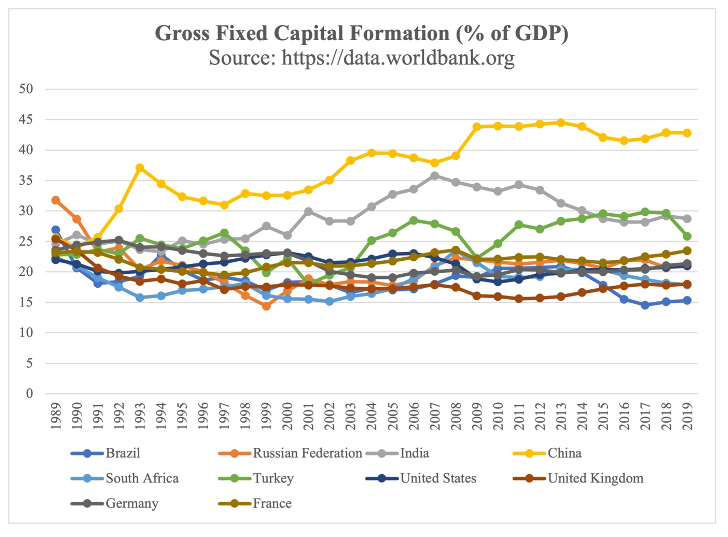
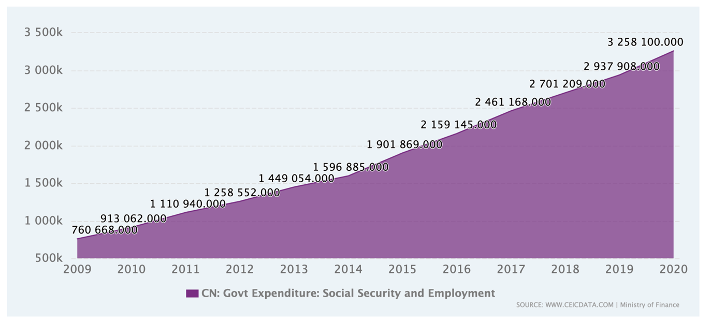
Source: https://www.ceicdata.com/en/china/government-revenue-and-expenditure/government
expenditure-social-security-and-employment
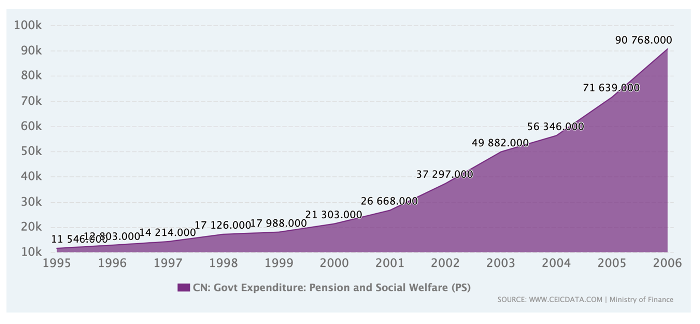
Source: https://www.ceicdata.com/en/china/government-expenditure-by-other-category/government-expenditure-pension-and-social-welfare-ps
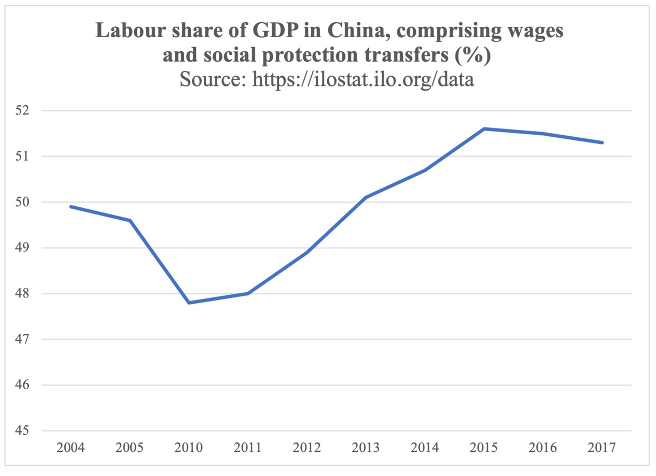
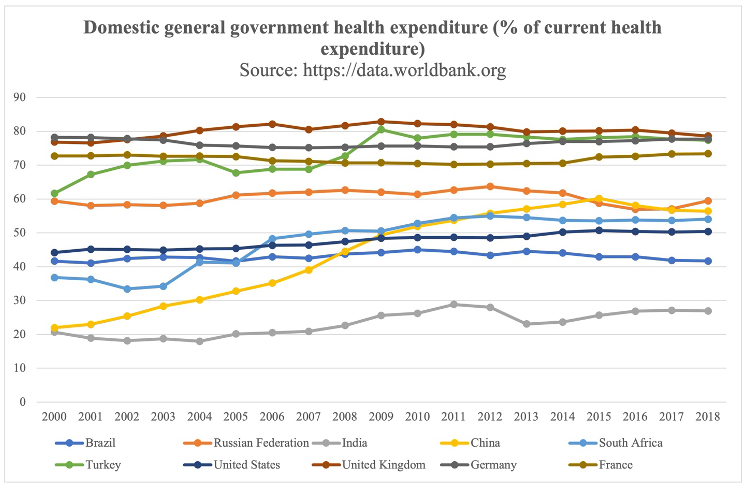
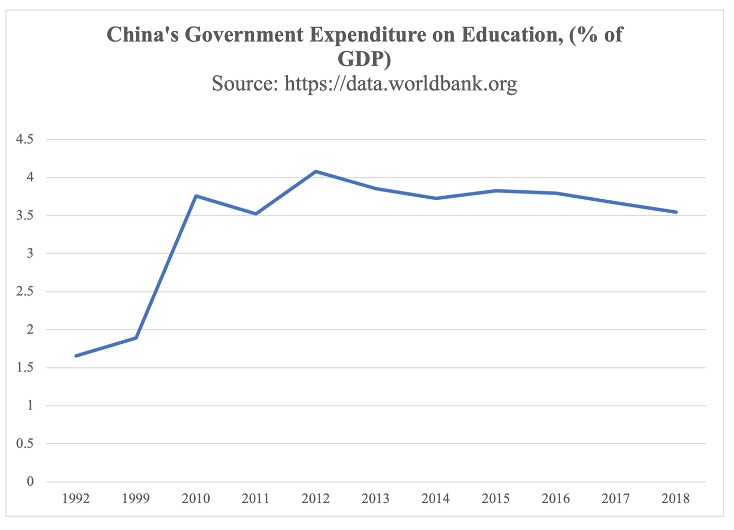
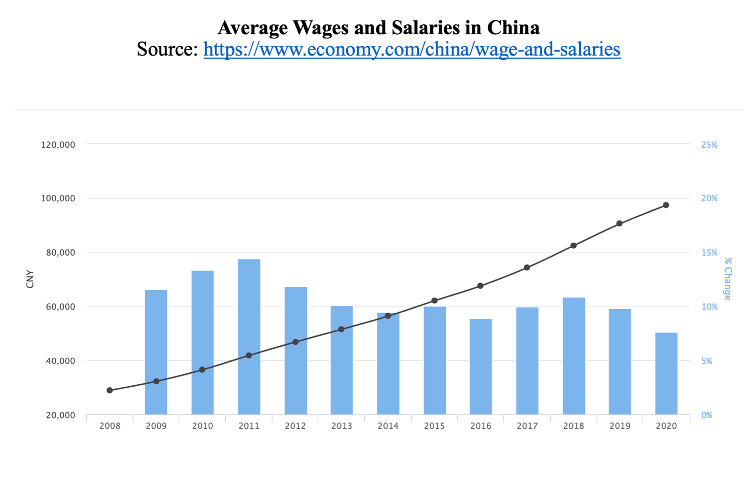
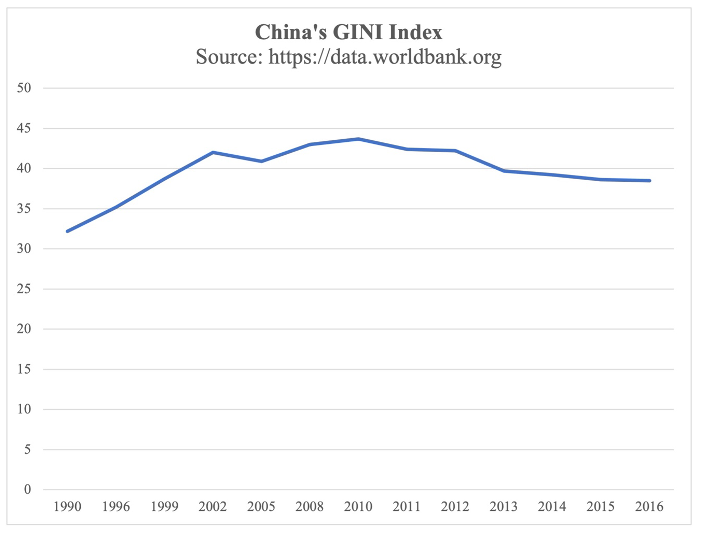
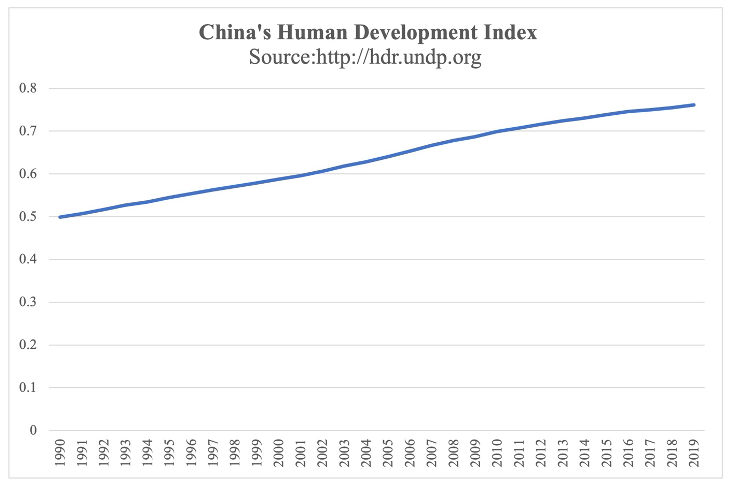
China’s shift to a more people-oriented economic policy framework gained significant pace under the Xi administration. This administration has continued Hu’s vision of core socialist values, deepened the struggle against corruption and inequality, and achieved notable successes in eliminating pro-American elements from the state as a continuation of Hu’s diligent efforts (Martin, et al., 2021; Dorfman, 2018). In a world characterised by the decline of US global hegemony and the multipolarization of global politics (Gürcan, 2019; Gürcan, 2021b), Xi strives to restore China’s self-confidence and wealth, which finds its fullest expression in the notions of the doctrine of “Four Matters of Confidence” and the “Chinese Dream”. The origins of the “Four Matters of Confidence” can be traced back to a speech delivered by Hu at the 18th CPC Party Congress, where he pointed to the importance of maintaining confidence in the future of socialism, the scientific nature of socialism as a theory, and the superiority of socialism as a system. In 2014, Xi added a fourth component, which stresses confidence in the value and vitality of Chinese culture. China’s growing self-confidence, driven by intensifying geopolitical rivalry and the country’s sustained economic success, also finds its expression in the notion of the “Chinese Dream” (Gürcan, 2021b; China Research Center, 2012). Xi describes the Chinese Dream as:
“A dream cherished and aspired to by the Chinese people and nation, a dream of building China into a well-off society in an all-round way and rejuvenating the Chinese nation, a dream for everyone to make his own dream come true, a dream that the whole nation strives for, and a dream to show the world China’s commitment to making a greater contribution to the peace and development of mankind” (Xi, 2014a: 179).
As such, the Chinese Dream calls for the rejuvenation of the Chinese nation by further deepening Hu’s vision of equitability and sustainability, without however losing sight of Deng’s modernisation plan:
“We will continue to give top priority to development; put people first; persist in reform and opening up; comprehensively promote economic, political, cultural, social, and ecological progress; and spur coordinated progress of every aspect of the modernization drive” (Xi, 2014b: 8-12).
For what came to be known as Xi Jinping Thought, the keys to such rejuvenation are “better education, more stable jobs, more satisfactory income, greater social security benefits, better medical and health services, more comfortable living conditions and a more beautiful environment” (Xi, 2014b: 16). Worthy of special emphasis in this regard is how Xi frames the working class as the “main force for finishing building a moderately prosperous society” (Xi, 2014b: 56; Gürcan, 2021b).
Under the Xi administration, China’s state-guided economic development model –where the state determines the general course of economic development based on long-term plans and strategies– attained a higher degree of maturity. This level of maturity finds its expression in the Decision of the Central Committee of the Communist Party of China on Some Major Issues Concerning Comprehensively Deepening the Reform:
The basic economic system with public ownership playing a dominant role and different economic sectors developing side by side is an important pillar of the socialist system with Chinese characteristics and is the foundation of the socialist market economy. Both the public and non-public sectors are key components of the socialist market economy, and are important bases for the economic and social development of China. We must unswervingly consolidate and develop the public economy, persist in the dominant position of public ownership, give full play to the leading role of the state-owned sector, and continuously increase its vitality, controlling force and influence. We must unwaveringly encourage, support and guide the development of the non-public sector, and stimulate its dynamism and creativity (CPC, 2014).
Therefore, one could deduce that in China’s economic development model, public ownership plays a dominant role with due regard for the balance between economic and socio-environmental development and harmony between the public and non-public sectors.
In this context, it is no coincidence that the Chinese economy and its success continue to heavily rely on state-owned enterprises (SOEs), which accounted for 40% of China’s GDP in 2020 (Guluzade, 2020). The main function of SOEs as the engine of the Chinese economy lies in supporting capital-intensive industries and large undertakings beyond the means of free market actors, contributing to the public goods beyond the sole profit motive, and correcting market failures (Tay, 2013, Lin, et al., 2020; Wu & Fan, 2014: 69). Under reform and opening up, SOEs gained greater autonomy, where the responsibilities of central and local governments were expanded alongside those of outside directors. In the 2010s, greater support was also granted to commercial SOEs operating in strategic sectors that are deemed important for national security (Lin, et al., 2020). Even though the reform and opening up led to a reduction in SOEs from 262,000 in 1997 to 173,000 in 2016, their assets soared from around 12.5 trillion RMB to 155 trillion RMB.
Similarly, their net income witnessed a significant increase, from nearly 79.12 billion RMB to 2.5 trillion RMB (Lin, et al., 2020: 4). An overwhelming majority of revenues by SOEs is derived from the strategic or top-tier sectors comprising defense, electricity, oil, gas, telecommunications, coal, shipping, aviation, and rail. A substantial part of SOE revenues is generated by the pillar or middle-tier industries comprising automobiles, chemicals, construction, electronics, equipment manufacturing, nonferrous metals, prospecting, steel, and technology. Lately, biotechnology and alternative energy manufacturing have also been included in the middle-tier industries (Asia Society Policy Institute, 2021; Pearson, 2015). Moreover, it is also important to note that “private companies, whether individual, small/medium-sized or hi-tech start-ups are not ‘free’, since they are heavily dependent on local party members” (De Rambures, 2014: 4). Equally important is how large private companies such as Huawei enjoy substantial government support and forge organic relations with the People’s Liberation Army (De Rambures, 2014). Such examples reveal that socialism and state-guided development do not necessarily contradict the private sector.
More can be said about the increasing importance of China’s state-guided economic development model despite reform and opening up. In 1995, the CPC launched an initiative called “retain the large; release the small” (fangxiao) through sales and merger and acquisition activity, which resulted in a more limited number of highly mega-firms emerged” with greater economic and political power (Wu & Frazier, 2018: 132; Pearson, 2015). Large SOEs still maintain a dominant position in the economy, e.g. “computers (Lenovo), petroleum (Petrochina, Sinopec), chemicals (Sinochem), public works (Sandy), aerospace (AVIC), shipyards (Ronsheng), steel (Baosteel), appliances (Haier)” (De Rambures, 2014: 34). Furthermore, 19 out of China’s 20 largest companies are state-owned or state-controlled companies that determine the course of the economy. These companies are among the top 150 corporations ranked by Fortune Global 500 and mostly operate in the oil, chemicals, utilities, banking, insurance, construction, telecommunications, and automotive industries (Wu & Frazier, 2018). The world’s four largest banks –as the main engine of China’s economic development– belong to China’s public sector (i.e. the Industrial & Commercial Bank of China, the China Construction Bank, the Agricultural Bank of China, and the Bank of China). Therefore, they exert a strong influence on the Chinese economy and global economic change. Worthy of note here is that the number of SOEs listed in Fortune Global 500 witnessed an upward trend in the 2000s, with their number increasing from 49 in 2005 to 102 in 2017 (Wu & Frazier, 2018).
The main characteristic of the Chinese model of economic development lies in that “the market is ‘driven’ by a strong government, and the state sector guides the national economy” (Wu & Fan, 2014: 69). State guidance on the economy allowed China to accumulate large amounts of capital and strategically mobilize this accumulated wealth to support the expansion of a productive economy (Yongding, 2014). As such, China stands out as the top performer in gross savings (as a % of Gross National Income, or GNI) among the leading imperialist and developing countries such as the BRICS grouping (i.e. Brazil, Russia, India, South Africa) and Turkey. China’s performance exceeded 50% of its GNI in the 2007-2010 period (see Figure 11). This is also reflected in the spectacular rise of general government capital stocks, public-private partnership investments, and private capital stocks (see Figures 12-14). In the 2000-2015 period alone, general government capital stocks witnessed an over 374.5% increase (See Figure 12). This led China to develop the largest industry (as a % of GDP) in our entire sample and become the top performer in medium- and high-tech manufacturing (as a % of manufacturing, value added) among developing countries (see Figures 15-16).

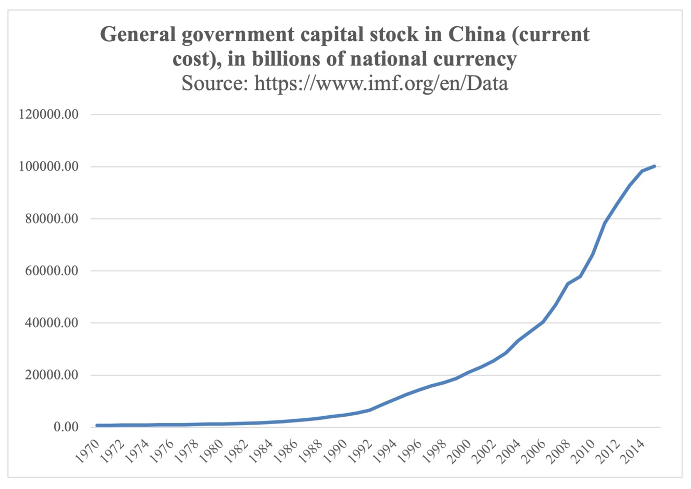
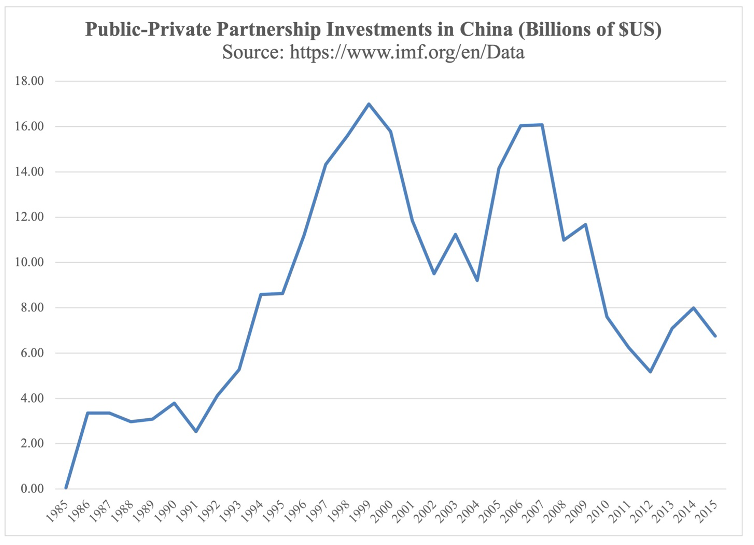
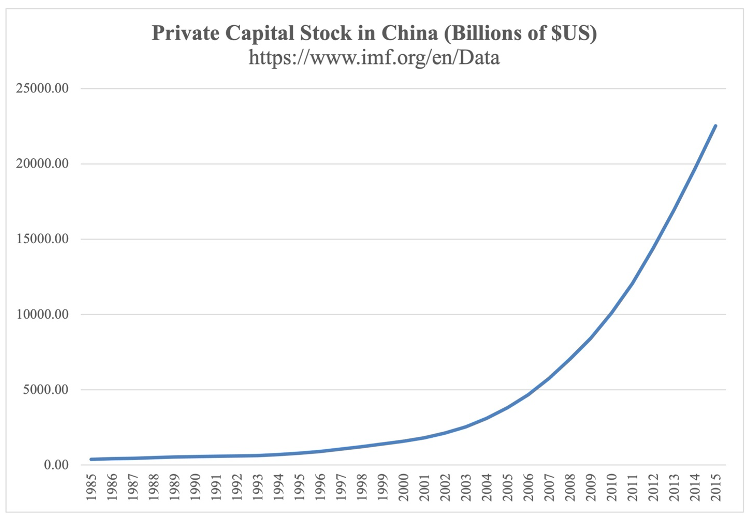
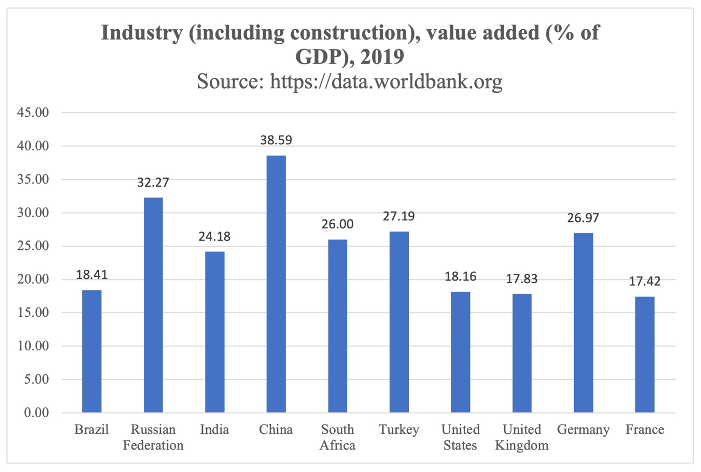

The mere growth of capital stocks does not automatically serve the goals of permanent and long-term economic development unless they are mobilized to trigger technological progress and innovation. For developing countries, the scale of mobilization required to take targeted advances necessitates strong state guidance and strategic planning, given that the spontaneous functioning of free markets cannot satisfy such requirements. This also applies to China, whose national science and innovation system was created at the 1978 National Conference on Science and Technology Work convened by the Central Committee of the CPC. In this conference, Deng declared science and technology as part of productive forces. The 6th Five-Year Plan in 1982 launched China’s first National Program for Science and Technology Projects, which paved the way for the National Technological Transformation Plan in 1982, the National Key Scientific and Technological Breakthrough Plan in 1982, the National Key Laboratory Construction Plan in 1984, the National High-Technology Development Plan in 1986, and the Spark Program (Zheng, et al., 2020). The year 1988 marked the creation of national development zones for new and high-technology industries. An important landmark in developing China’s national science and innovation system is the adoption of the Law on Scientific and Technological Progress in 1993, which promotes the progress of science and technology as foundations of economic construction and social development (Zheng, et al., 2020). This legal environment provided new momentum for implementing national programs in the 1990s and the early 2000s, including the National Basic Research Program, the Knowledge Innovation Program, and the National Science and Technology Innovation Program. Two important landmarks in the late 2000s and the 2010s were the implementation of the National Medium- to Long-Term Plan for the Development of Science and Technology and the formulation of the Outline of National Innovation-Driven Development Strategy (Zheng, et al., 2020). The former is a 15-year plan for the period 2006-2020, which calls for “indigenous innovation” (zizhu chuangxin) based on a strong synergy between firms, universities, and research institutes. It encourages indigenous innovation through government-funded R&D and state-guided megaprojects in strategic industries (Naughton, 2018). The latter provides a strategic roadmap for China’s scientific and technological development in three steps:
Step 1, China should become an innovative country by 2020 to give strong support for building a moderately prosperous society in all respects;
Step 2, China should move to the forefront of innovative countries by 2030 to lay a solid foundation for building China into a major economic power and a society of common prosperity;
Step 3, China should become an innovation power by 2050 to support the building of a prosperous, strong, democratic, culturally advanced, harmonious, modern socialist country and the realization of the Chinese dream of national renewal (Minister of Science and Technology, 2016).
This outline identifies strategic areas to include smart and green manufacturing and energy technologies, humanlike machine intelligence, natural interaction and virtual reality, microelectronics and optoelectronics, broadband mobile Internet, cloud computing, the Internet of things, Big Data, high-performance computing, mobile intelligent terminals, independent hardware and software products and network security technology, modern agricultural technology, and marine, space, and medical technologies (CSET, 2019).
China views science and technology as a complementary pillar of its economic development. This is the main reason why China’s industrial strategies also reflect a science- and technology-driven approach. A case in point is Made in China 2025, China’s national strategic plan for industrial policy as part of “Industry 4.0”. Launched in 2015, this plan calls for integrating new technologies into the economy and developing a national industrial base led by indigenous innovation. It thus provides a general framework to mobilize state support for key industries such as information, technology, robotics, green energy, sustainable transportation, aerospace technology, ocean engineering and high-tech ships, railway equipment, new materials, and pioneering medical and agricultural technologies. High-tech companies operating in these industries are to be supported through tax incentives, subsidies, low-interest loans, R&D funding, and assistance for acquisitions of foreign technology companies (Huimin, et al. 2018; US Chamber of Commerce, 2017). Another plan launched in 2015 is an action plan called Internet Plus, which aims to use, through fiscal and tax policies, state resources to encourage the application of mobile and digital technologies into the economy, particularly to manufacturing, commerce, finance, medical sectors, government, and agriculture. This plan brands mobile Internet, cloud computing, big data, and the Internet of Things as the driving technologies of the Chinese economy (China Daily, 2015).
Within such policy frameworks, China has devoted its efforts to increase its R&D expenditure (as a % of GDP), which rose from 0.56% in 1996 to 2.14% in 2018. This makes China one of the world’s top performers in R&D expenditure, which is mainly driven by government funds (see Figure 17; Zheng, et al., 2020). Moreover, China’s strong state guidance and strategic planning yielded significant results in its performance related to several important indicators, including the publication of scientific and technical articles, the number of researchers engaged in R&D, and patents, trademarks, and industrial applications by residents. For one thing, available data reveals that China has become the world’s leading country in scientific publications, having overtaken the United States in 2016 (see Figure 18). In a similar vein, the number of researchers engaged in China’s R&D rose by almost 200%, from around 437 million persons in 1996 to 1.3 billion persons in 2018 (see Figure 19). China also witnessed impressive growth in the number of patents, industrial design, and trademark applications by residents. This points to an increase of over 12308% for patent applications and 9040% for industrial design applications between 1992 and 2019. In the period 2004-2019, China’s increase in trademark applications amounted to 1337%. Consequently, 2019 data show that China has become the world’s leading nation in patent, industrial design, and trademark applications (e.g. See Figures 19-21). Eventually, the mobilization of capital stocks to support technological progress and innovation under strong state guidance has transformed China’s international trade. 2019 data reveal that China is now a country with the world’s largest share of informational and communication technology (ICT) goods exports in total goods exports and high technology exports in total manufactured exports (see Figure 22). Here, ICT goods include information and technology goods, such as computers, communication equipment, consumer electronic equipment, electronic components, whereas high-technology exports involve a longer list of items that supplement ICT goods, including aerospace, pharmaceuticals, scientific instruments, and electrical machinery.
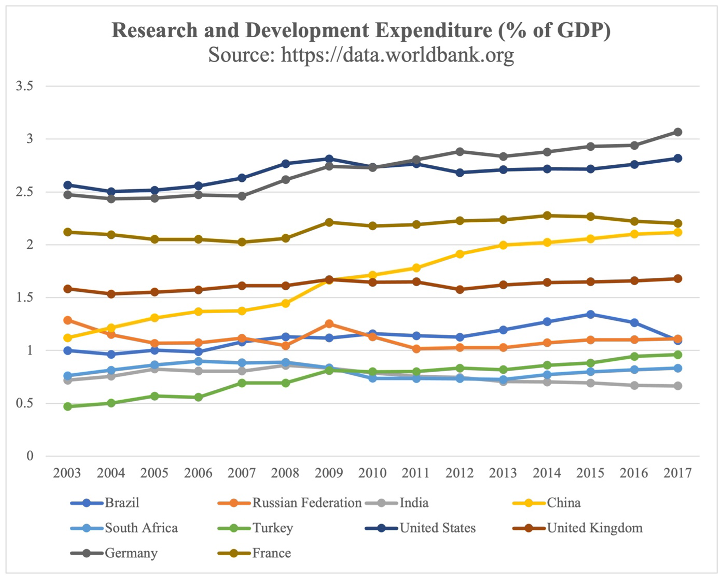
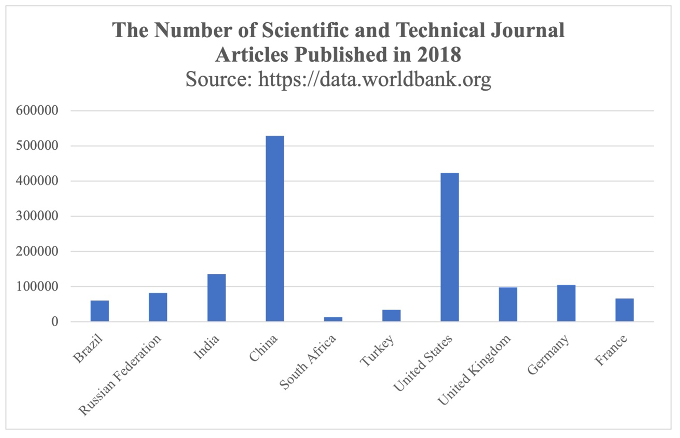
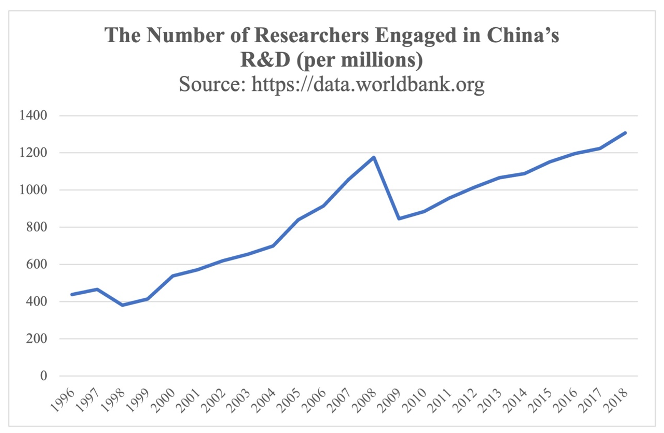
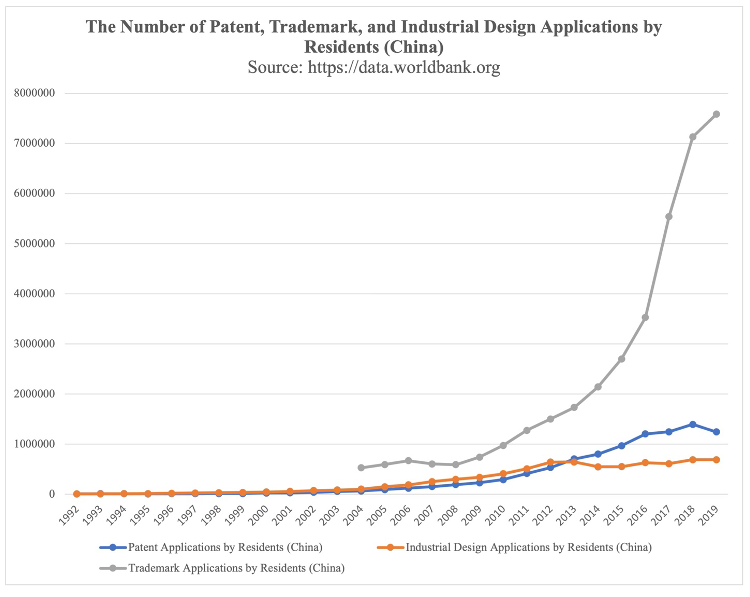
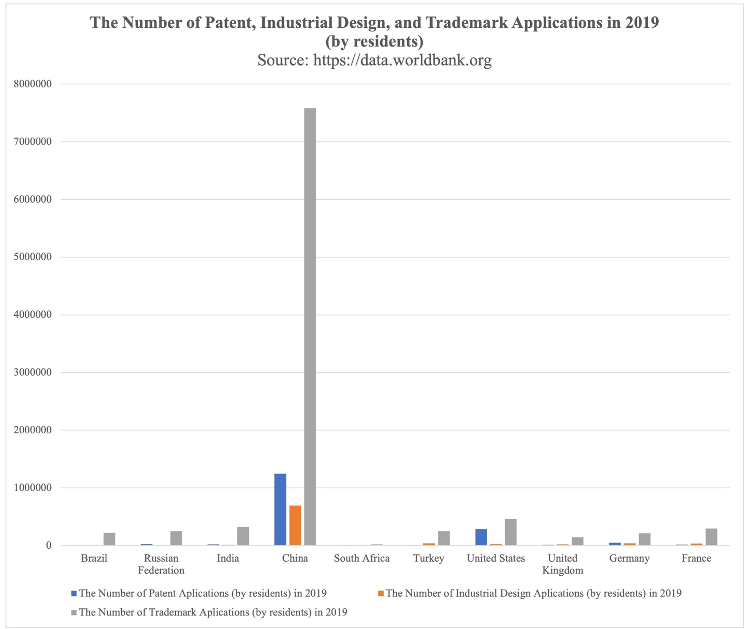
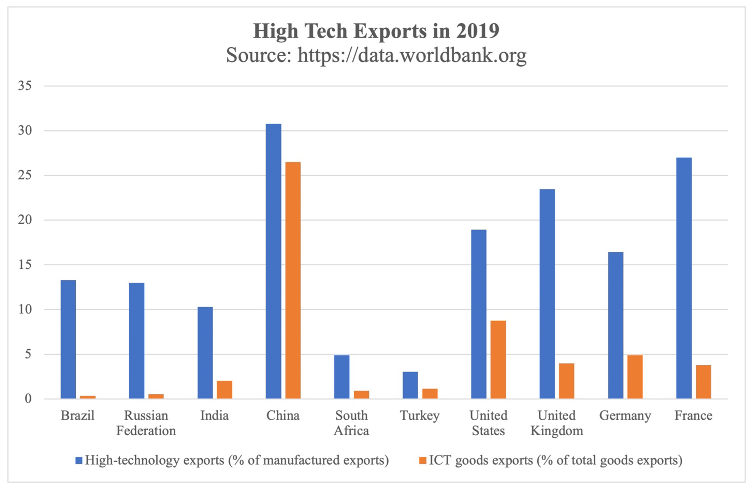
A final word is needed regarding the relationship between the Chinese economic miracle and the Belt & Road Initiative (BRI). Eventually, the success of the Chinese economic model has allowed China to gain the status of an “agenda-setter” and “norm-maker” in international politics with the rise of China-led initiatives such as the BRI. The BRI focuses on five primary areas: intergovernmental political cooperation and consensus building, infrastructural and technological connectivity, commercial connectivity, financial integration, and people-to-people exchange for cultural cooperation. While the term “belt” indicates land pipelines, roads, and railways, the term “road” is used to define offshore lines, harbors, and other maritime facilities. Launched in 2013 on China’s initiative, the BRI aims at establishing broad networks related to infrastructure, natural resources, and investments in more than 152 countries across Asia, Europe, Africa, the Middle East, and the Americas. Today, the BRI covers over 70 countries, corresponding to more than 65% of the world population, one-third of the global GDP, and a quarter of world trade. This suggests that the BRI has become the most comprehensive development and trade cooperation scheme in history (Gürcan, 2020).
Two crucial observations are worth highlighting at this point. First, the BRI itself reflects China’s state-guided economic approach. For example, Chinese state-owned banks and the Silk Road Fund, created by the collective efforts of these banks, constitute the engine of the BRI’s financial integration and infrastructure investments. Second, the BRI encourages participant countries to adopt a state-guided economy that values infrastructure development and environmental sustainability. A case in point is the Asian Infrastructure Investment Bank (AIIB) as the BRI’s financial locomotive, which started to operate in 2016 under China’s initiative as “the world’s first multilateral development bank (MDB) dedicated to infrastructure” (Wilson, 2017). In the Second Belt and Road Forum for International Cooperation, moreover, the BRI publicly announced its principles for green investment, which later led to the creation of several initiatives for sustainability, such as the International Coalition for Green Development, Sustainable Cities Alliance, Climate Change Cooperation Initiative, Environmental Technology Exchange and Transfer Center, Environmental Big Data Platform, and Green Investment Fund. As part of the Green Belt project, the BRI thus promotes green finance, sustainable energy, green agriculture, eco-urbanization, and social sustainability (Gürcan, 2021a).
Conclusion: Debunking the Myths about the Chinese Miracle
The “cheap labor thesis”, i.e. the myth that China owes its economic success mainly to the supply of cheap labor, is often used to derogate China’s historic success. In many respects, this article serves to debunk this myth by evincing the Chinese economic miracle and how it has been achieved based on empirical evidence. The findings are hoped to provide developing countries with considerable insights into how advanced levels of economic development can be attained through a socialist market economy understood as an early phase in the construction of socialism. This phase consists of building a state-guided economy that leads the market forces, where public ownership is used to fuel techno-industrial development and a sustainable autocentric economy, albeit closely integrated into the global economy. The leadership of a revolutionary party ensures not only strategic coherence and long-term planning, but also correction of market failures and protection from foreign political interference and economic manipulations.
The “cheap labor thesis” is not the only derogatory term to describe the Chinese economic miracle from a Western-centric perspective. Such biased approaches include Mao’s so-called “brutal” legacy, the role of foreign investments and integration into global capitalism, China’s “technology theft”, and “Chinese imperialism”. First and foremost, the evidence suggests that China’s long-term success greatly owes to Mao’s “socialism with Chinese characteristics”, which laid the foundations for human and physical capital necessary for economic development. Indeed, foreign investments do not choose any destination where labor is cheap, given that attracting foreign investments requires a sound physical and human capital infrastructure in the first place. This being said, it would be equally misleading to reduce China’s economic success to merely attracting foreign investment. Quite the contrary, the Chinese miracle is postulated on an autocentric model. It follows that China’s secret lies in attracting foreign investments and using state power to maximize technology transfer and strengthen the socialist system. Moreover, based on the foreign investment thesis, some argue that the Chinese miracle mostly emanates from China’s renunciation of socialism and integration into global capitalism. In their view, China has developed a shared interest with Western capitalists in joining so-called “global imperialism”. However, the intensification of a new Cold War between the United States and China, which insists on improving its socialist system, rather invalidates such arguments (Gürcan, 2019).
One cannot also equate China’s technology transfer with technology theft. Technology theft is often deployed as a “stigma” to denigrate China and diffuse Sinophobia. At this point, it would be helpful to recall that even the US economy greatly owes its previous success to state-sponsored and systematic technology theft. In his book Trade Secrets: Intellectual Piracy and the Origins of American Industrial Power, Doron S. Ben-Atar depicts the chief role of spies in launching the American industrial revolution “by illicitly appropriating mechanical and scientific innovations from Europe” (Macleod, 2005: XXI). He describes the systematic technology theft by the US as part of “policies relating to intellectual property played in promoting the appropriation of smuggled technology which led to the emergence of the United States as the premier industrial power in the world” (Macleod, 2005: XXI).
Finally, the globalization of Chinese SOEs is often misinterpreted as a sign of China becoming an imperialist power. Capitalism and imperialist policies inevitably lead to wars. Western capitalism is strongly predicated on systemic wars such as the Thirty Years’ War, the Napoleonic Wars, World War I, and World War II. Moreover, the so-called Western economic success greatly owes to the forced accumulation of wealth through colonialism and slavery rather than the miracle of free markets (Wallerstein, 2002; Williams, 2021; Beckert, & Rockman,2016). In contrast to Western capitalism, the Chinese economic miracle does not originate from forced accumulation, wars, and colonialism. On the contrary, it springs from peaceful development and international cooperation. Understood as such, China’s model also constitutes the living example of the rising relevance and superiority of socialism over the capitalist system.
References
Asia Society Policy Institute. (2021). State-Owned Enterprise: State-Owned Enterprise Policy Reform. Retrieved from https://chinadashboard.gist.asiasociety.org/winter-2021/page/state-owned-enterprise
Beckert, S., & Rockman, S. (Eds.). (2016). Slavery’s capitalism: A new history of American economic development. University of Pennsylvania Press.
CGTN. (2020). Five-Year Plans map out China’s future development. Retrieved from https://news.cgtn.com/news/2020-05-15/Five-Year-Plans-map-out-China-s-future-development-QvANs2JxVS/index.html
Chan, J. (2018). Economic growth and labor security. The SAGE Handbook on Contemporary China. Thousand Oaks, CA: SAGE, 166-188.
Chen, J., Dai, D., Pu, M., Hou, W., & Feng, Q. (2010). The trend of the Gini coefficient of China. Brooks World Poverty Institute Working Paper, (109).
China Daily. (2011). The 10th Five-Year Plan (2001-2005), Retrieved from http://www.chinadaily.com.cn/china/2013npc/2011-02/23/content_16261366.htm
China Daily. (2015). China Unveils ‘Internet Plus’ Action Plan to Fuel Growth. Retrieved from https://www.chinadaily.com.cn/business/tech/2015-07/04/content_21181256.htm
China Research Center. (2012). The 18th Party Congress: A Turning Point in Chinese Politics?, Retrieved from https://www.chinacenter.net/2012/china_currents/11-2/the-18th-party-congress-a-turningpoint-in-chinese-politics/
CPC, Communist Party of China. (1991). Major Documents of the People’s Republic of China (1978-1989). Peking: Foreign Languages Press.
CPC, Communist Party of China. (2014). Decision of the Central Committee of the Communist Party of China on Some Major Issues Concerning Comprehensively Deepening the Reform, 19 May 2016, Retrieved from http://www.china.org.cn/china/third_plenary_session/2014-01/16/content_31212602_2.htm
CSET. (2019). Outline of the National Innovation-Driven Development Strategy, [中共中央 国务院印发《国家创新驱动发展战略纲要》], Xinhua News Agency. Retrieved from https://cset.georgetown.edu/research/outline-of-the-national-innovation-driven-development-strategy/.
Currie-Alder, B., Kanbur, R., Malone, D. M., & Medhora, R. (Eds.). (2014). International development: ideas, experience, and prospects. Oxford: Oxford University Press.
De Rambures, D. (2014). The China development model: between the state and the market. Springer.
Deng, X. (1984). Selected Works Vol. III. Beijing: Foreign Languages Press.
Deng, X. (1987). Fundamental Issues in President Day China. Beijing: Foreign Languages Press.
Dollar, D., Huang, Y., & Yao, Y. (Eds.). (2020). China 2049: Economic challenges of a rising global power. Washington: Brookings Institution Press.
Dorfman, Z. (2018). Botched CIA communications system helped blow cover of Chinese agents. Foreign Policy. Retrieved from https://foreignpolicy.com/2018/08/15/botched-cia-communications-system-helped-blow-cover-chinese-agents-intelligence/
Gardner, D. K. (2018). Environmental Pollution in China: What Everyone Needs to Know. New York: Oxford University Press.
Guluzade, A. (2020). How reform has made China’s state-owned enterprises stronger. In World Economic Forum, May (Vol. 21). Retrieved from https://www.weforum.org/agenda/2020/05/how-reform-has-made-chinas-state-owned-enterprises-stronger/
Gürcan, E. C. (2008). Düşünce ve Eylemde Tarih Bilinci ile Tarih Bilimi. Bilim ve Ütopya, 14(168), 65-67.
Gürcan, E. C. (2019). Multipolarization, south-south cooperation and the rise of post-hegemonic governance. London: Routledge.
Gürcan, E. C. (2021a). On the development of China’s environmental policies towards an ecological civilization. Belt & Road Initiative Quarterly, 2(3): 7-25.
Gürcan, E. C. (2021b). Towards a Cultural Political Economy: Contemporary Socialism with Chinese Characteristics. In (Ed. D. Pietzcker) Dragon Games: Historical and Contemporary Figurations in European-Chinese Relations (pp. 165-176). Würzburg: Ergon Verlag.
Gürcan, E. C. 2020. Uluslararası işbirliğinde yeni bir döneme doğru paylaşarak gelişme konsepti. Retrieved from http://www.medyatakip.com/medya_sistem/yb_kupurgoster.php?gnosif=AiQoEK-xZLimCVp7MJgTdw..&mnosif=4_8VEwskDKM.&st=2
Gürcan, E. C., & Mete, B. (2017). Neoliberalism and the changing face of unionism: the combined and uneven development of class capacities in Turkey. London: Springer.
Gürcan, E. C., Kahraman, Ö. E. & Yanmaz, S. (2021). COVID-19 and the Future of Capitalism: Postcapitalist Horizons Beyond Neo-Liberalism. Nova Scotia: Fernwood Publishing.
Harrison, G. (2020). Developmentalism: The Normative and Transformative Within Capitalism. Oxford: Oxford University Press.
Hu, J. (2007). Hu Jintao’s report at 17th Party Congress. Retrieved from https://www.chinadaily.com.cn/
Hu, X. (2020). Forecast of China’s Average Annual Economic Growth Rate Based on BP Neural Network. J. Phys.: Conf. Ser. 1629 (1): 2040.
Huimin, M., Wu, X., Yan, L., Huang, H., Wu, H., Xiong, J., & Zhang, J. (2018). Strategic Plan of “Made in China 2025” and Its Implementation. In Analyzing the Impacts of Industry 4.0 in Modern Business Environments (pp. 1-23). IGI Global.
Ikenberry, G. J., & Lim, D. J. (2017). China’s Emerging Institutional Statecraft: The Asian Infrastructure Investment Bank and the Prospects for Counter-Hegemony. Brookings.
Jiang, Z. (2002). On the” three Represents.”. Peking: Foreign Languages Press.
Kiely, R.(2015). The BRICs, US ‘Decline’and Global Transformations. London: Palgrave Macmillan.
KOF Globalisation Index: World Data, Retrieved from https://kof.ethz.ch/en/forecasts-and-indicators/indicators/kof-globalisation-index.html
Lin, K. J., Lu, X., Zhang, J., & Zheng, Y. (2020). State-owned enterprises in China: A review of 40 years of research and practice. China Journal of Accounting Research, 13(1), 31-55.
MacLeod, C. (2005). Trade Secrets: Intellectual Piracy and the Origins of American Industrial Power. Technology and Culture, 46(2), 443-444.
Mao, Z., (1961). Selected Works IV. Peking: Foreign Languages Press.
Mao, Z., (1967). On New Democracy. Peking: Foreign Languages Press.
Mao, Z., (1971). Selected Readings from the Works of Mao Tsetung. Peking: Foreign Languages Press.
Mao, Z., (1974). Mao Tse-tung Unrehearsed: Talks and Letters, 1956-71. Harmondsworth: Penguin.
Mao, Z., (1977). A Critique of Soviet Economics. New York: Monthly Review Press.
Marino, R. (2018). Chinese Trade: Trade Deficits, State Subsidies and the Rise of China. London: Routledge.
Martin, P., Jacobs, J. & Wadhams, N. (2021). China Is Evading U.S. Spies — and the White House Is Worried. Bloomberg. Retrieved fromhttps://www.bloomberg.com/news/articles/2021-11-10/china-under-xi-is-tough-target-for-cia-spies-hurting-biden-s-beijing-policy
Ministry of Science and Technology. (2016). Outline of the National Strategy of Innovation-Driven Development Background Briefing. Retrieved from http://www.china.com.cn/zhibo/zhuanti/ch-xinwen/2016-05/23/content_38515829.htm
Morton, K. (2006). International Aid and China’s Environment: Taming the Yellow Dragon. London: Routledge.
Naughton, B.J. (2018). The Chinese Economy: Adaptation and Growth (second edition). Cambridge: MIT Press.
Odell, J. S. (2001). Case study methods in international political economy. International studies perspectives, 2(2), 161-176.
Pearson, M. M. (2015). State-owned business and party-state regulation in China’s modern political economy. State capitalism, institutional adaptation, and the Chinese miracle, 27-45.
PRC, People’s Republic of China. (2006). 11th Five-Year Plan (2006-2010) for National Economic and Social Development. Retrieved from https://policy.asiapacificenergy.org/node/115
Tay, S. S. (2013). Asian model of development: from crises to transformation. In International development: ideas, experience, and prospects. Currie-Alder, B., Kanbur, R., Malone, D. M., & Medhora, R. (Eds.). Oxford: Oxford University Press.
US Chamber of Commerce. (2017). Made in China 2025: Global Ambitions Build on Local Protections. Retrieved from https://www.uschamber.com/assets/archived/images/final_made_in_china_2025_report_full.pdf
Wallerstein, I. (2002). The itinerary of world-systems analysis; Or, how to resist becoming a theory. New directions in contemporary sociological theory, 358-376.
Wang, Q. K. (2011). The Rise of Neoclassical Economics and China’s WTO Agreement with the United States in 1999. Journal of Contemporary China, 20(70), 449-465.
Williams, E. (2021). Capitalism and Slavery. UNC Press Books.
Wilson, J. D. 2017. What does China want from the Asian Infrastructure Investment Bank? (Report). USAsia Centre. https://researchrepository.murdoch.edu.au/id/eprint/37439/ Accessed 9 August 2021.
Wu, J. (1996). On Deng Xiaoping Thought. Peking: Foreign Languages Press.
Wu, J., & Fan, S. (2014). China’s Economic Reform–Processes, Issues, and Prospects (1978–2012). Routledge Handbook of the Chinese Economy, New York: Routledge, 55-75.
Wu, W., & Frazier, M. (Eds.). (2018). The SAGE Handbook of Contemporary China. London: SAGE.
Xi, J. (2014a). The governance of China. Peking: Foreign Languages Press.
Xi, J. (2014b). The Chinese Dream of the great rejuvenation of the Chinese nation. Peking: Foreign Languages Press.
Yongding, Y. (2014). Macroeconomic management of the Chinese economy since the 1990s. In Routledge handbook of the Chinese economy (pp. 158-176). London: Routledge.
Yueh, L. (2018). Evolution of market reforms. The SAGE Handbook of Contemporary China, 101.
Zakaria, F. (2011). The Post-American World: Release 2.0. New York: W. W. Norton & Company.
Zheng, S., Zhuang, Q., & Wang, Y. (2020). China’s Innovation Capacity in 2049. China 2049: Economic Challenges of a Rising Global Power, Brookings Institution Press, 235.
Zhu, R. (2001). Report on the Outline of the Tenth Five-Year Plan for National Economic and Social Development (2001). Retrieved from http://www.npc.gov.cn/zgrdw/englishnpc/Special_11_5/2010-03/03/content_1690620.htm
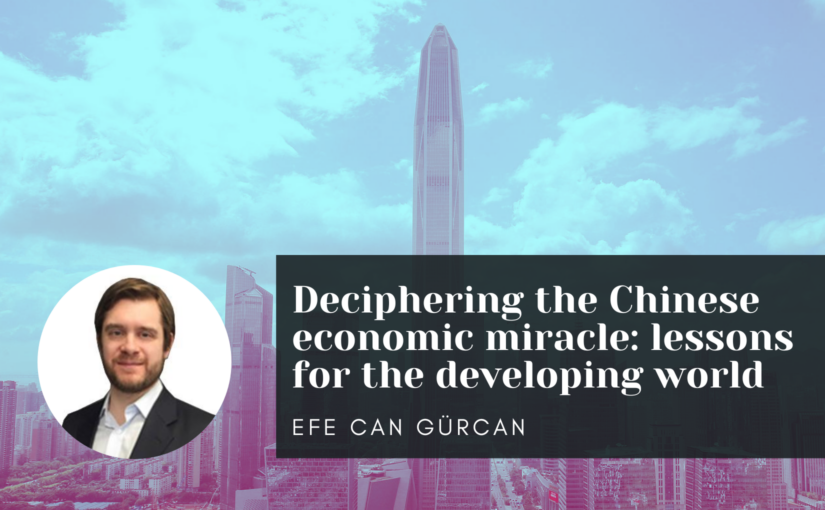

I am from Vancouver,Canada and i wanted to say that with Capitalism progress is for the minority not the majority.A federal gov’t as opposed to a central Gov’t makes sure of that. Private Property makes the minority rich and the majority poor.
The Chinese Economic Miracle can’t occur under such conditions.
Look at western Europe and you will see what Imperialist Capitalism leads to.That wouldn’t happen in China because Socialism wouldn’t let what is happening in Europe to happen in China.
Socialism unites the world while Capitalism breaks up the world. That is there for everyone to see especially in Europe. In China there is hope for the world. In Canada,USA and Europe there is very little hope unless Socialism comes to these countries.